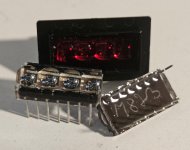Eudimorphodon
Veteran Member
Recently bought a grab bag of assorted LED displays. Most of them were HP/Agilent HP5082-7651 7-segment units which were very clearly marked and trivial to look up... but hiding in the corner of the sack were these three weirdos, which look *very* old and primitive. Only one came with the red diffuser/panel mount box, the other two were bare. The only marking on them is a hand-lettered scribble that's inside the clear plastic molded around the module; it looks like it reads "M823" (same on both uncased units).

I know it's a heck of a long shot, but do these look familiar to anyone? There's no obvious sign of a manufacturer mark.
They only have 13 pins (DIP-14 format with one pin absent in either the pin 1 or pin 8 position) so I would guess they need to be driven in a multiplexed fashion. If anyone has a pointer to a datasheet for anything even vaguely like them that'd at least be a start. I guess I could try gently probing them with low voltage through a high current limiting resistor and see if I can suss it out, but I'd kind of hate to kill them.
(Not that I really know what to use them for, but they seem too cool *not* to find an excuse to use.)

I know it's a heck of a long shot, but do these look familiar to anyone? There's no obvious sign of a manufacturer mark.
They only have 13 pins (DIP-14 format with one pin absent in either the pin 1 or pin 8 position) so I would guess they need to be driven in a multiplexed fashion. If anyone has a pointer to a datasheet for anything even vaguely like them that'd at least be a start. I guess I could try gently probing them with low voltage through a high current limiting resistor and see if I can suss it out, but I'd kind of hate to kill them.
(Not that I really know what to use them for, but they seem too cool *not* to find an excuse to use.)
